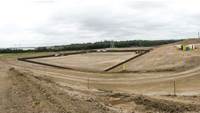How long do you think it will take for HP to reverse its decision not to offer its channel the chance to offer managed services from its big new Sydney data centre?
HP executives, announcing an initial $119 million investment in a modular data centre build in the Western Sydney area of Eastern Creek today, told journalists that the facility was primarily being built for the vendor’s own enterprise service customers (the former EDS business) and its plans to become a cloud computing provider.
“This is not basic floor space here,” said HP regional vice president Paul Brandling [pictured], when asked if HP would offer any co-location opportunities within the new facility.
“This is for outsourcing services to HP customers. Invariably we will have the relationship with the customer.”
David Caspari, vice president of enterprise services at HP, noted that this wasn’t exactly a change on HP’s existing approach to market.
But that’s still a big shame for HP’s managed service provider channel. Access to this kind of plant, connectivity options and compute power would have been a great opportunity.
Dell, by contrast, is playing a role as a custom data centre and server vendor for those managed service providers building cloud computing services. Its latest big investment in Australia – the Tier 5 facility in Adelaide – is uncharacteristically more “channel friendly” than HP’s latest effort.
I guess there are good reasons HP doesn’t want to enter the data centre space game. Here’s three of them - Global Switch’s new Sydney facility will be 34,000 square metres (and its existing Sydney facility 42,000), Equinix is also expanding its Sydney facilities, and Macquarie Telecom wants to build out a 20,000 square metre site in Sydney’s North West.
HP would not want to find itself competing dollar for dollar with brokers of independent data centre space with its comparably smaller 11,500-odd square metres of space.
Also, the US vendor isn’t just building out a room with all the mod-cons in terms of plant, as you’d find in an Equinix or a Global Switch, but kitting it out with (primarily) the vendor’s latest server and networking gear as a compute cloud. Whilst Caspari made it clear that customers would dictate precisely what servers, storage and networking kit is hosted, the company clearly wants to convince customers it migrates into the new facility that they are better off on a standardised, highly-virtualised modular stack that HP can assumedly manage at lower cost.
Imagine the potential as-a-service offerings HP’s channel could have realised running on that stack?
CRN editor Sholto Macpherson points out to me that offering channel partners that opportunity might risk the premium HP could ask for its branded cloud services.
But I wonder whether eventually HP, like NEC, might find a place for channel partners – even as it offers services directly from the same facility.
NEC, you might recall, had some initial difficulties filling its allotment at the 6000 square metre Polaris data centre in Brisbane, and has since invited co-lo deals with smaller players to maximise its return.
What do you think? Will HP need to do the same?









_(21).jpg&h=142&w=230&c=1&s=1)


.png&h=142&w=230&c=1&s=1)



.jpg&w=100&c=1&s=0)
_(8).jpg&w=100&c=1&s=0)










